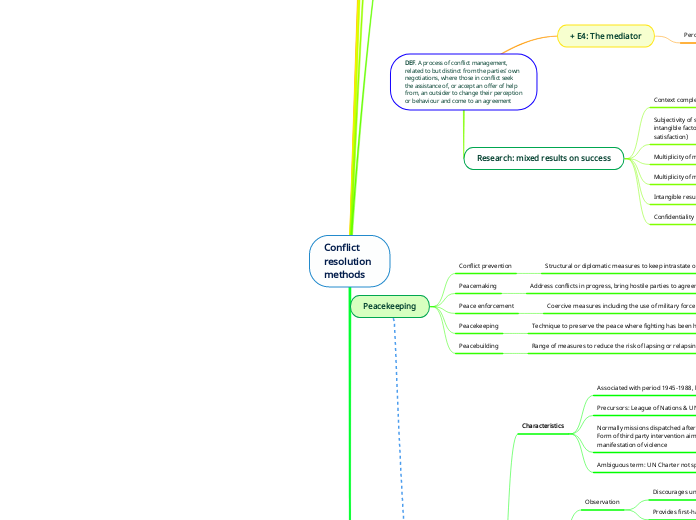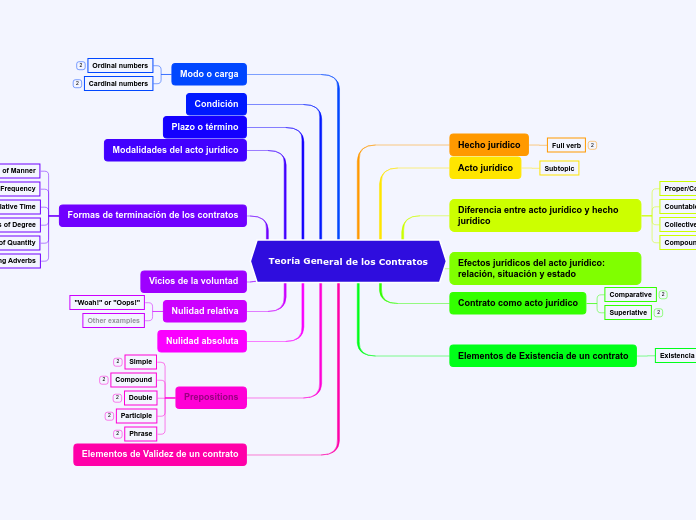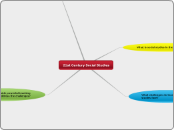Factors affecting success
Timing of mediation
Mediator's traits
Conflict level or intensity (costs incurred by parties)
Issues in conflict (underlying causes and perceptions)
NM Deadlock
Main causes
Deadlock itself increases tension and parties become more inflexible
Entrapment: party invested to much in the conflict and doesn't wanna sacrifice it
Absence of acceptable solution
Lack of motivation (conflict better serves party's interests)
Uncertainty on the characteristics of the agreed outcome
Low motivation, inflexible position, lack of commitment
Stalemate, extended delay, or complete breakdown.
Situation where there is no progress, no concessions, continued violence, perception of immobility and inactivity.
Main characteristics
- Intervention of an outsider
- Non-coercive, non-violent, non-binding
- Mediators come with background
- Mediators have own interests/agendas
Difference NM: additional resources, expanded relationship, and communication possitibilities that a mediator brings to the process.
Main characteristics
- Process embedded in socially system
- Voluntary process (all have to agree)
- Mixed motive relationship (common and conflicting interests)
- Perceptions matter (strategies to influence the other's perception: demands, threats, concessions, promises, etc)
- Balance between cooperation and maximising own interest
- Sequential rather than simultaneous
- Particularly useful in low-intensity conflicts
DEF. A process by which states and other actors communicate and exchange proposals in an attempt to agree about the dimensions of conflict termination and their future relationship
Wide spectrum of activities, multinational, multilateral forms. Formal, informal conversations.
Actors: states, regional organisations (UN), non-state actors, multilateral corporations, private individuals, etc.
Humanitarian intervention NOT = Humanitarian assistance
DEF. A process of conflict management, related to but distinct from the parties’ own negotiations, where those in conflict seek the assistance of, or accept an offer of help from, an outsider to change their perception or behaviour and come to an agreement
Research: mixed results on success
Confidentiality
Intangible results can't be quantified
Multiplicity of mediation aims and scope
Multiplicity of mediation styles
Subjectivity of success (idea of success linked to intangible factors such as justice or personal satisfaction)
Context complexity calls for context specific analysis
+ E4: The mediator
Perception of the mediator by the parties
Legitimacy, credible
Positive attitude & disposition
Independent: ensure neutral agreements, look for both interests
Conflict resolution methods
Humanitarian Intervention
Assesing UN PK
Research
Qualitative
Bleak picture
Quantitative
UN effective
Objective track record is positive
11 out of 16 successful missions
Bad reputation for no reason
PK are sent to the most difficult places
Makes it harder to get high rates of success (wouldnt make sense to send them where there would be peace anyway)
Also affects budget (ex. US reduced it)
Public remembers failure more vividly
Inexpensive (very little budget)
Challenges
Operational
Institutional limitations in the way the UN operates: complex command structures from different countries, haven't trained together, financing, resources available, etc.
Political
UN aims for consensus and states can block proposed solutions. Politically sensititve. Ex military needed but not interested
Normative
HI should not make matters worse (ex. Iraq)
Legal
non intervention vs. human rights
All other cases problematic: can we intervene?
2 unproblematic cases: complete state failure and genocide
WHEN & HOW to intervene?
Basis of HI
Theoretical basis: lessons learnt from PK operations in the 80s-90s forces the UN to accept new tasks and expand its role
Legal normative basis: lies in changes to the international order
Human rights gained momentum in the 90s
Political basis: end of Cold War and expansion of UN's role in conflict resolution
Involvement in the late 80sin active conflicts set precedent
Wide spread of optimism
Increasing demand for UN services
End of a super power hostility
Charter basis is ambiguous
Differences with TPK
Context
HI often take place in an active phase of conflict, where there hasn't been a ceasefire (like TPK).
Principles
TPK is based on consent, impartiality and non-use of force. In HI forces are often used and needed to protect civilians, they are given the authority to use violence.
Aims
Instead of neutral interposition, targeted directly at preventing human rights abuses and enforcing peace.
Tasks
Expanded tasks, involving other activities (delivering aid rebuilding infrastructure, repatriation refugees, capturing war criminals, etc).
Actors
Not only military forces playing a role, also other actos (organizations, NGOs, etc) that are involved.
Complex peace operations which combine
Peacebuilding: range of activities designed to address the roots of conflict and to create the conditions to create a durable and stable peace.
Peacekeeping: military operations designed to oversee ceasefires or the implementation of peace agreements.
Peacemaking: using diplomatic methods to bring method to an halt, like mediations.
Peace enforcement (sometimes)
TPK: Traditional PeaceKeeping
Problems & limitations
Limited by its own principle of impartiality
sometimes long term member is needed to set up a mission
Organisational problems
UN works by consensus (mandates watered down)
Financial problems
Practical/operational problems (many countries, languages, etc)
Freezing of conflict
Remove incentives for negotiation
Strenghts & advantages
Prove to be effective
Reputation of impartiality and professionalism in Cold War period
Gives UN relevance
Implementation of peace agreements
The third presence that supervises ceasefires and separates parties can lead to renewed confidence between the parties and help them establish a dialogue.
UN impartiality
Limiting the spread of violence
Control over process and outcome
Evaluation
Success depends on criteriia
Ability to promote resolution of the underlying issues
Unsuccessful
Contribution to limitation of armed conflict
Successfull
Key principles
Non use of force (except self-defence)
Strict impartiality
Consent of the parties
Main tasks
Separation of forces
Moral barrier
hostile actions would be attacking not only the opposite party but also the international community
Buffer zone in which only the UN operates
Discourages ceasefire breaches
Observation
Provides first-hand information
Discourages unreasonable behaviour
Characteristics
Ambiguous term: UN Charter not specifically mentioned
Normally missions dispatched after a ceasefire was signed. Form of third party intervention aimed at controlling the manifestation of violence
Precursors: League of Nations & UN observer missions
Associated with period 1945-1988, but still used today
Peacekeeping
Peacebuilding
Range of measures to reduce the risk of lapsing or relapsing into conflict and to lay the foundation for sustainable peace and development
Technique to preserve the peace where fighting has been halted, and to assist in implementing agreements achieved by the peacemakers
Peace enforcement
Coercive measures including the use of military force
Peacemaking
Address conflicts in progress, bring hostile parties to agreement
Conflict prevention
Structural or diplomatic measures to keep intrastate or interstate tensions and disputes from escalating into violent conflict
MEDIATION
8. Parties calculate that it will help them reach a better settlement that they can reach on their own, because:
Rejecting mediation will result in greater harm than accepting it.
The mediator is seen as a means of influencing their opponent.
The mediator will provide them a face-saving way out of the conflict.
7. A mediator must be available and willing to intervene in a dispute or conflict. There must be an opportunity for this mediator to get involved or intervene. If the parties wish to avoid any outside intervention, mediation won’t take place.
6. The parties own conflict management efforts have failed or reached an impasse. The antagonism between the conflict parties is so severe it prevents conflict management or direct negotiations.
5. When a dispute is long or very complex.
INTERNATIONAL NEGOTIATION
Preconditions
4. Flexibility by each of the conflict parties leadership to actually consider and embark upon a negotiation process.
3. Presence of common and compatible interests between the parties, or at least a possibility of a settlement offering mutual advantages over continued conflict.
2. A decreasing value of the conflict goals.
1. Low or decreasing probability of attaining conflict goals through violent struggle, withdrawal or avoidance.
Some kind of turningpoint: inconclusive victory/defeat, loss of foreign support, increase of foreign pressure, etc.
E3: The context
Characteristics
Environment in which conflict and negotiations are taking place. Additional factors that shape the context: history of the conflict, previous interactions of the parties, involvement of outside actors, etc.
Agenda: the government has many other issues besides the conflict
Phases: Articulation, mobilization, insurgency, warfare (Zartman)
E2: The issues
The nature of the dispute
Tangible issues (territory) are easier to solve than intangible issues (religion)
Parties often disagree on what the fundamental cause of the conflict it
Not fixed, may change over time
E1: The parties
Identity and characteristics
POWER RELATIONSHIPS (Zartman)
Ripe for resolution:
- Structural element (MHStalemate)
- Party element (presence valid spokesperson)
- Potential alternative outcome (formula way out)
Power assymetry > increasing commitement > narrow possibilities for negotiation
Negotiations work best under a mutually hurting stalemate Asymmetry of power makes it more difficult: if the rebellion exceeds the grievances the rebellion itself becomes the motivation, and governments have other interests as well.
Are they committed to a broader regional grouping or set of values (EU)?
Do the parties have similar attributes (EU members) or are they very different (democracy vs dictatorship)
Do the parties have subsystems?
Who should be represented?
What is the historical relationship?
Diplomacy
Track 3
Multitrack diplomacy (several simultaneously)
Individuals and private groups encourage interaction and mutual understanding between parties. Involves awareness raising. Meetings, media exposure, etc.
Track 2
Unofficial dialogue, influential academics, religious and ngo leaders, other civil society actors. Debate freely
1.5 Official & unofficial work together
Track 1
Official discussions, high level political and military leaders
Arbitration
Voluntary intervention: both parties have to agree to submit the dispute to an intervention. Limited task given to an arbitrator.
Adjudication
Decision making by adjudicator (judge, court, administrative tribunal). Decides the outcome of the dispute by a final, binding and enforceable solution.
Preventive diplomacy
Diplomatic actions taken to prevent disputes from escalating or limiting spread of conflict









